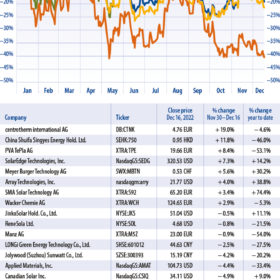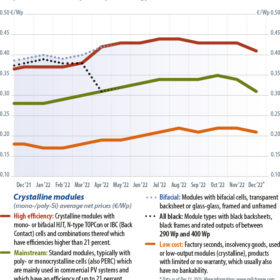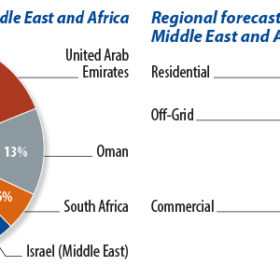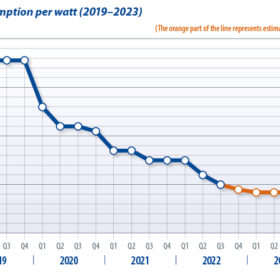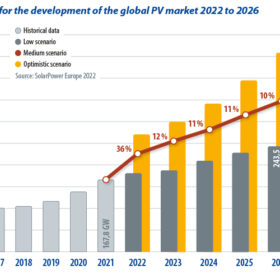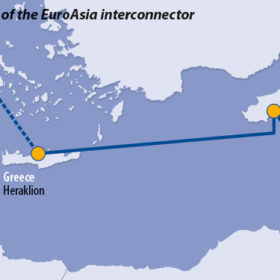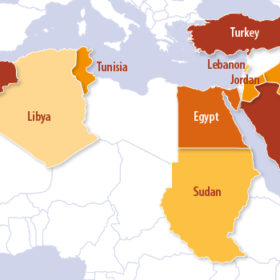Awakening of the solar age
As 2022 drew to a close, trade body SolarPower Europe (SPE) released its “EU Market Outlook for Solar Power 2022-2026” report. Forecasting year-on-year expansion of 47%, SPE found that 41.4 GW of PV were installed last year. The association expects the 50 GW annual installation milestone to be surpassed this year, swelling to 85 GW […]
Controversial California
In December, the Invesco Solar ETF, an exchange-traded fund that tracks the MAC Global Solar Energy Index, underperformed relative to the S&P 500 and the Dow Jones Industrial Average. Jesse Pichel, of ROTH Capital Partners attributes this to a possible US interest rate hike and California’s moves to pull the plug on rooftop solar.
A new year in PV
It looked as though 2022 might end on a quiet note, as supply chains and component prices stabilize, but December painted a very different picture. In PV modules, at least, there has been a lot of movement, says Martin Schachinger, of pvXchange. In some cases, discounts on individual products have been very significant – up to 9% in November 2022. Prices for new, grade-A solar modules have dropped nearly to the level they were a year ago. Is this the beginning of a long-term trend?
Tenders key for MEA growth
Solar installations in the Middle East and Africa (MEA) are expected to reach more than 260 GWdc of cumulative capacity in the 2022-30 period, driven by government utility-scale tenders, green hydrogen projects, and an increasing shift toward distributed generation (DG) and privately funded projects. S&P Global expects Saudi Arabia to lead in the deployment of new PV capacity in the region, alongside the United Arab Emirates, South Africa, Israel, and Morocco.
Less is more: The road to low-carbon solar
Polysilicon prices finally began to fall again at the end of 2022, following a period in which solar manufacturers made efforts to reduce silicon consumption in wafer production. With polysilicon accounting for around half of the carbon footprint of a typical solar panel – albeit with wide variation – further silicon reductions could offer a compelling route to low-carbon production, reports InfoLink Consulting chief analyst Corrine Lin.
Duty bound: US solar navigates choppy tariff waters
The Solar Energy Industries Association (SEIA) expects US solar additions to hit 15.7 GW in 2022, down 33% from 2021. Policy-driven supply constraints are the primary reason for the decline, as developers and original equipment manufacturers (OEMs) are struggling to navigate a raft of trade actions, including anti-dumping duties and measures to eliminate forced labor. Dan Shreve, vice president of market intelligence for Clean Energy Associates (CEA), reports.
From 300 GW to 3,000 GW per year – a utopia?
The photovoltaic industry is expected to achieve annual global expansion of 300 GW as early as this year. That sounds like a lot, but is it enough? In view of climate change and rising energy demand, it is time for a new vision, as pv magazine publisher Eckhart K. Gouras reports.
Connecting continents
New grid-linking plans in the European Union and the Middle East and North Africa (MENA) region, as well as the war in Ukraine, have placed discussions about electricity interconnectors at the center of the energy debate. Ilias Tsagas examines the projects that are making concrete steps and the factors that determine their success.
More than middling progress
There have been encouraging advances over the last 12 months in solar efficiency, floating PV, and agrivoltaics across the Middle East, with progress on green hydrogen ambitions, reports Zulfa Rasheed, and Hinde Liepmannsohn from the Middle East Solar Industry Association (MESIA).
Imminent comeback, imminent trouble
Once a European leader in PV deployment, the solar market in Czechia has slumbered for the last decade. Now, with growing public support and financing in place, momentum is building and a gigawatt-scale pipeline is taking shape. However, fresh challenges loom, as Marija Maisch reports.

